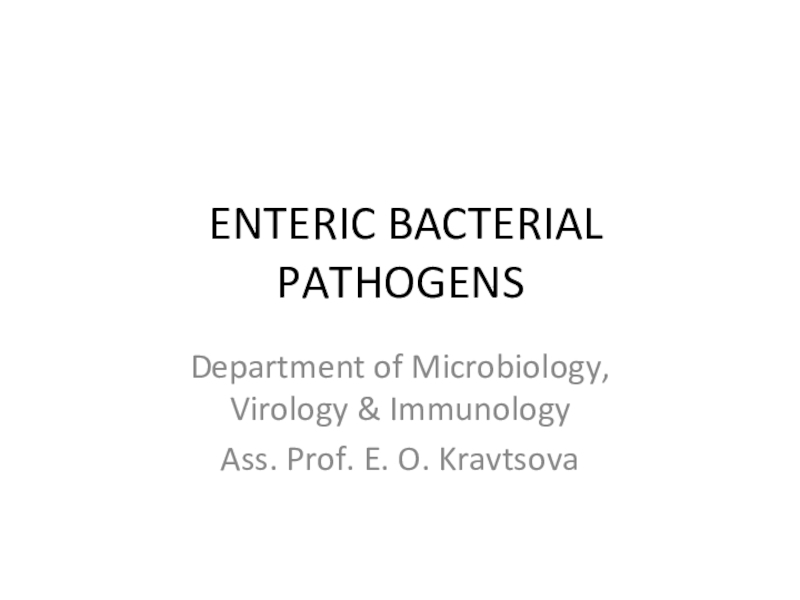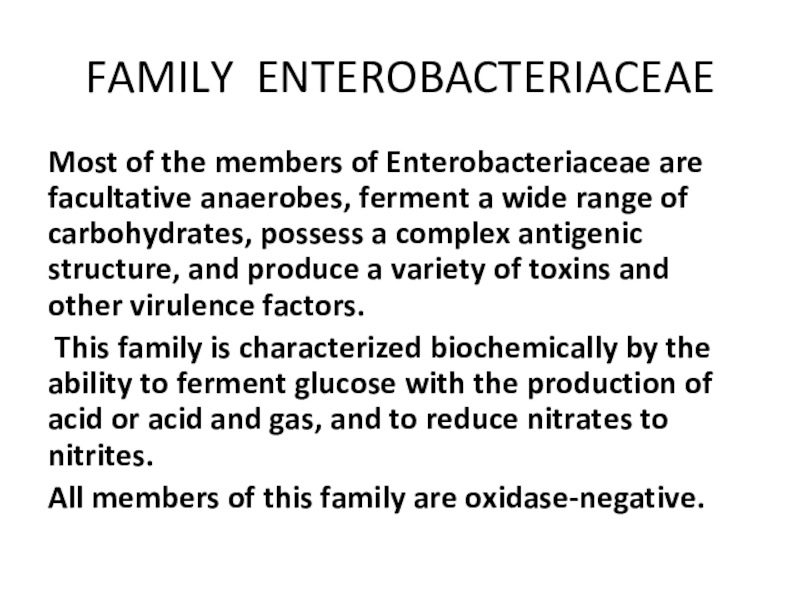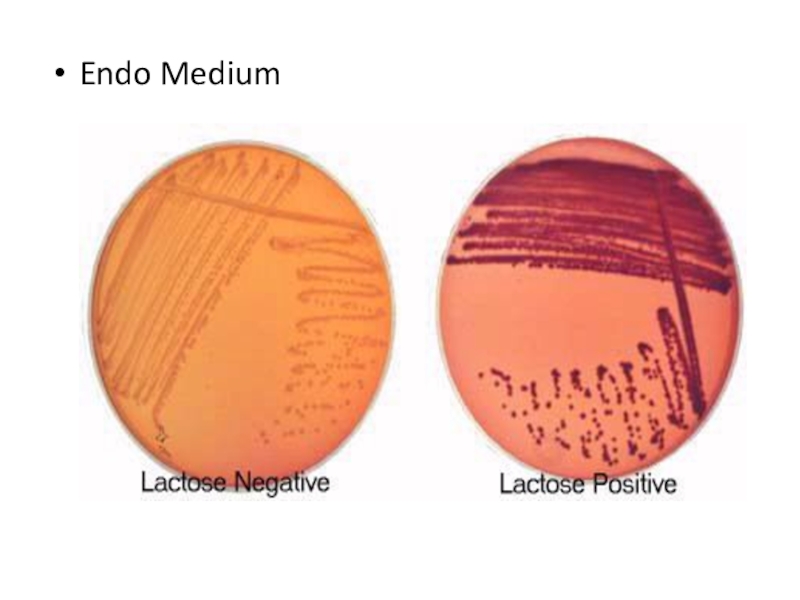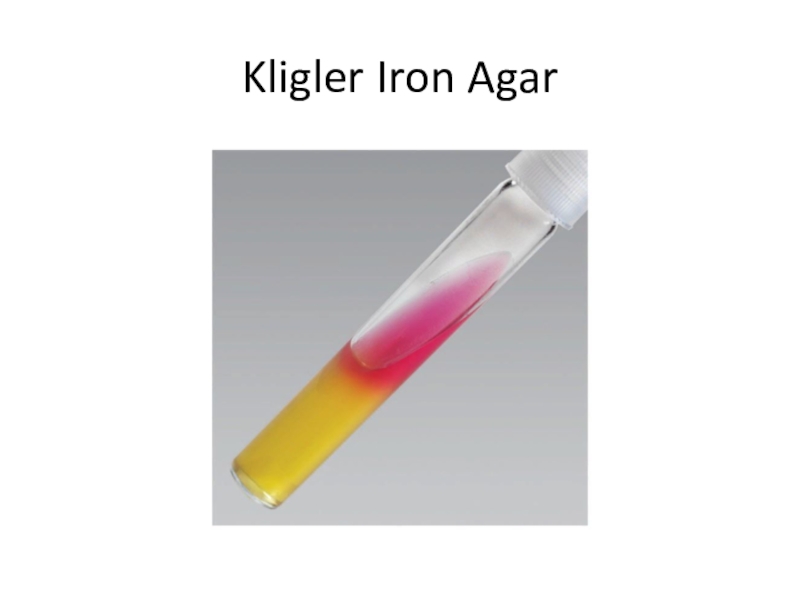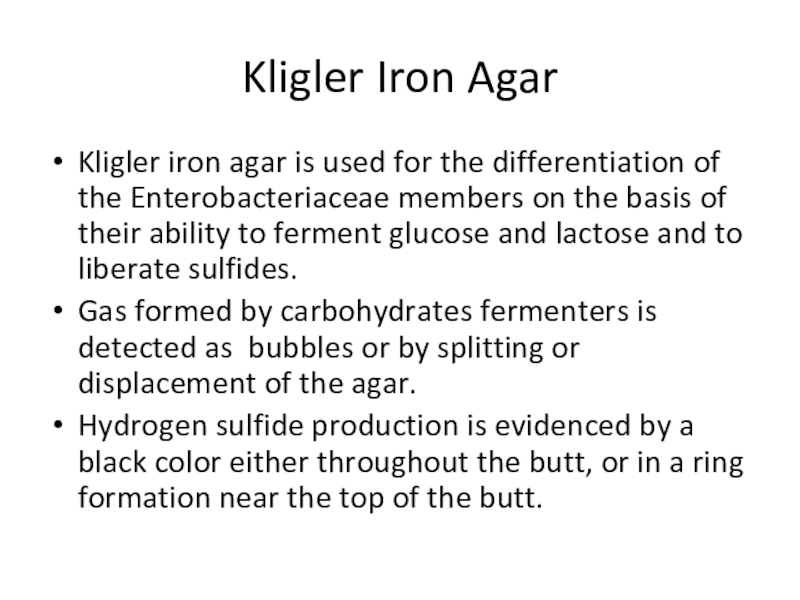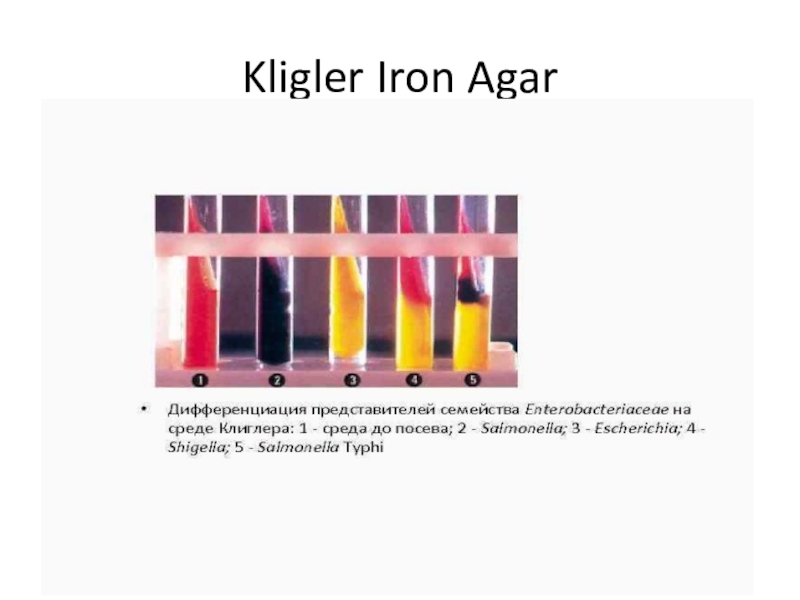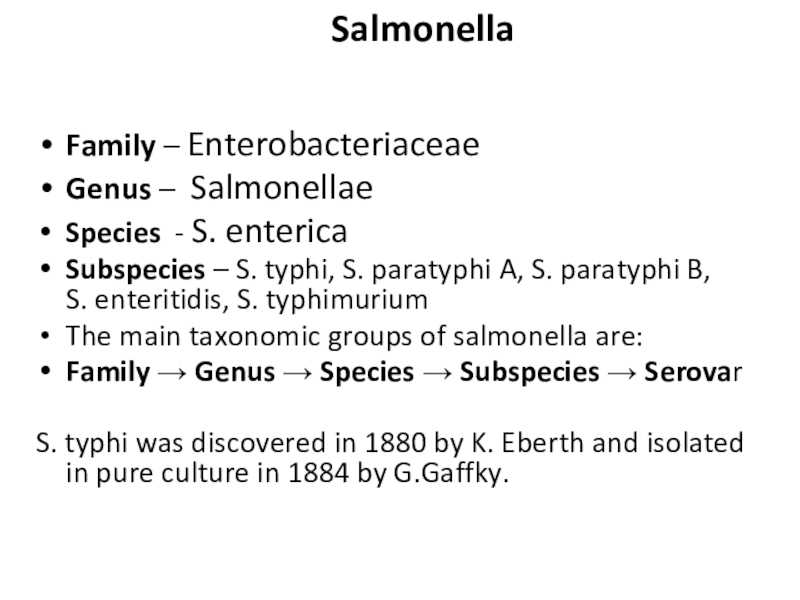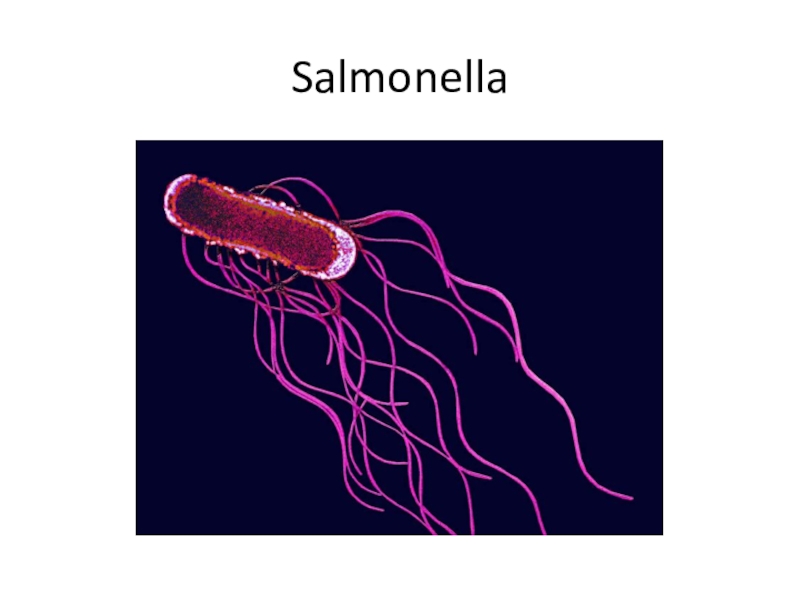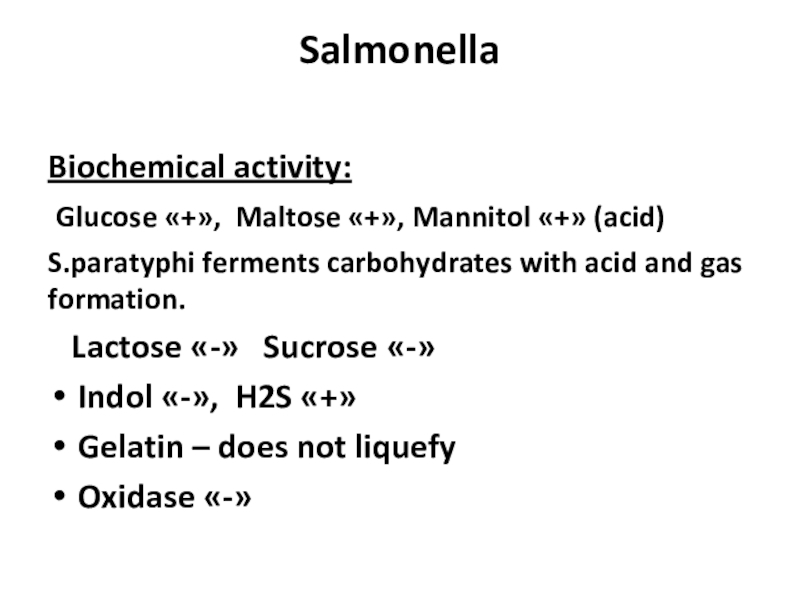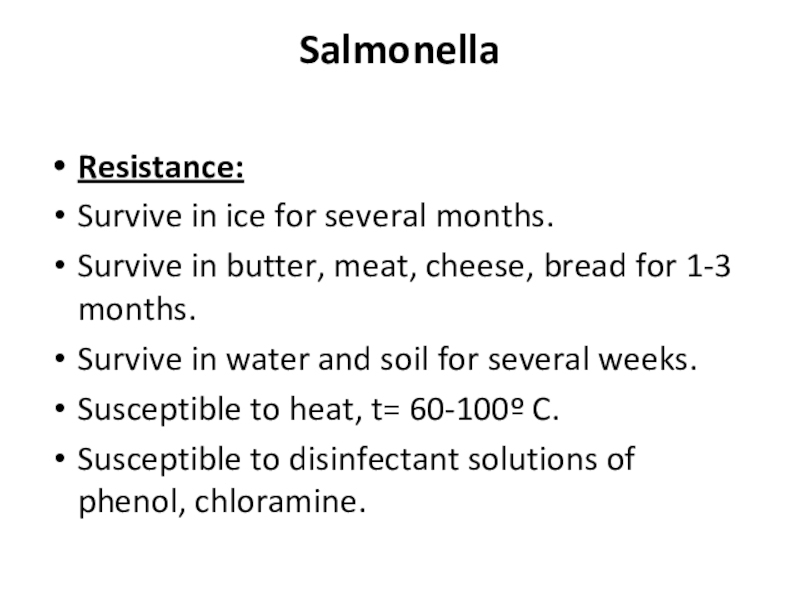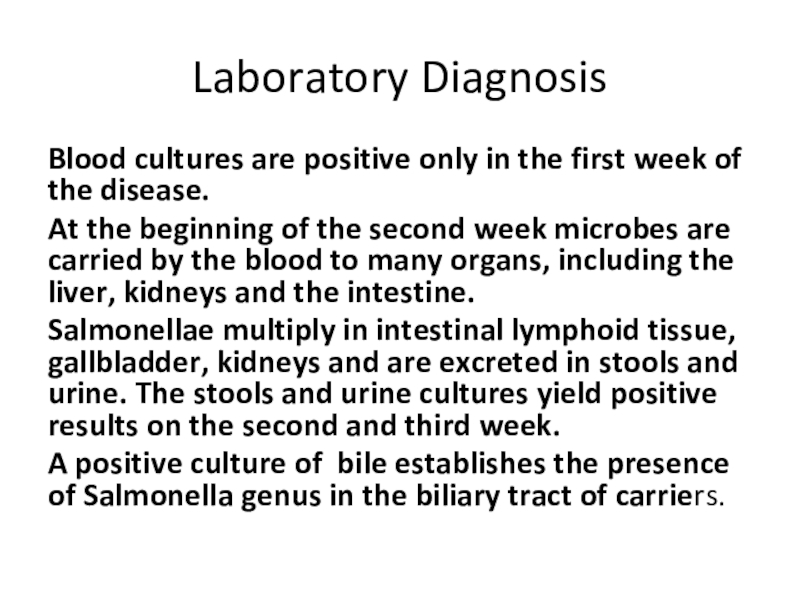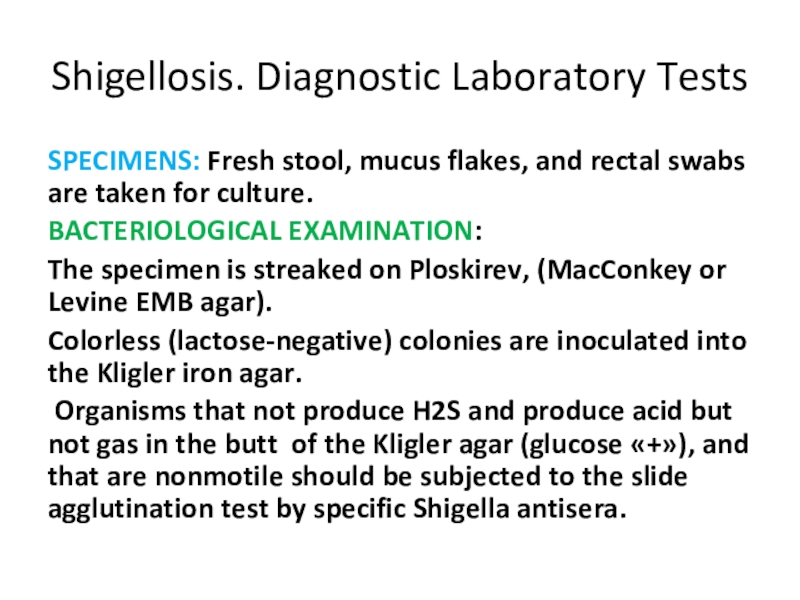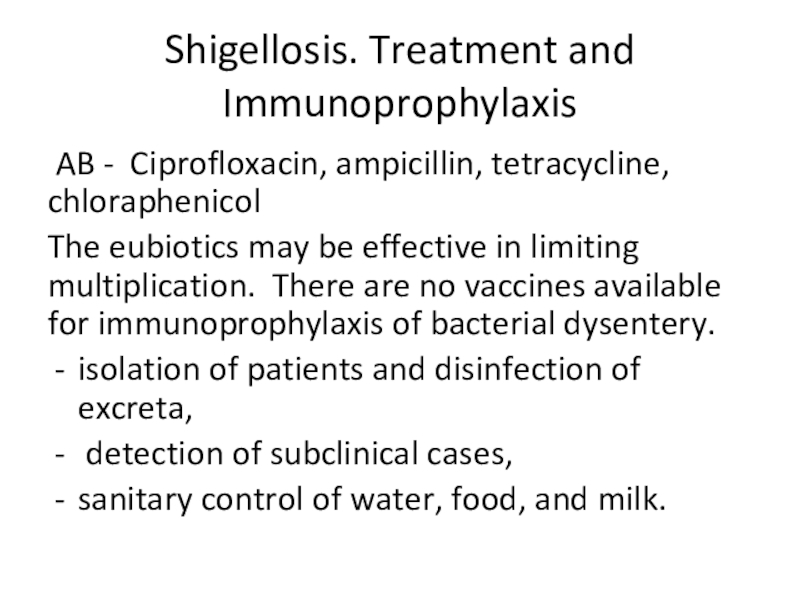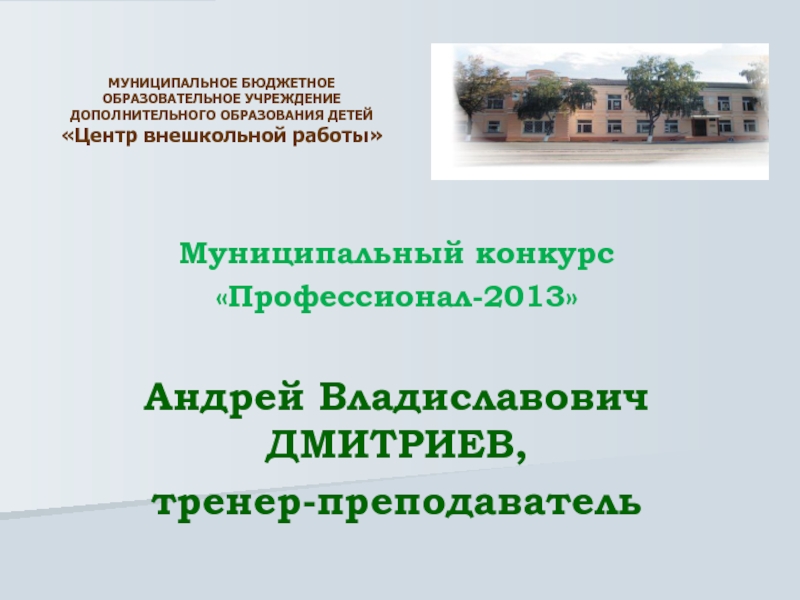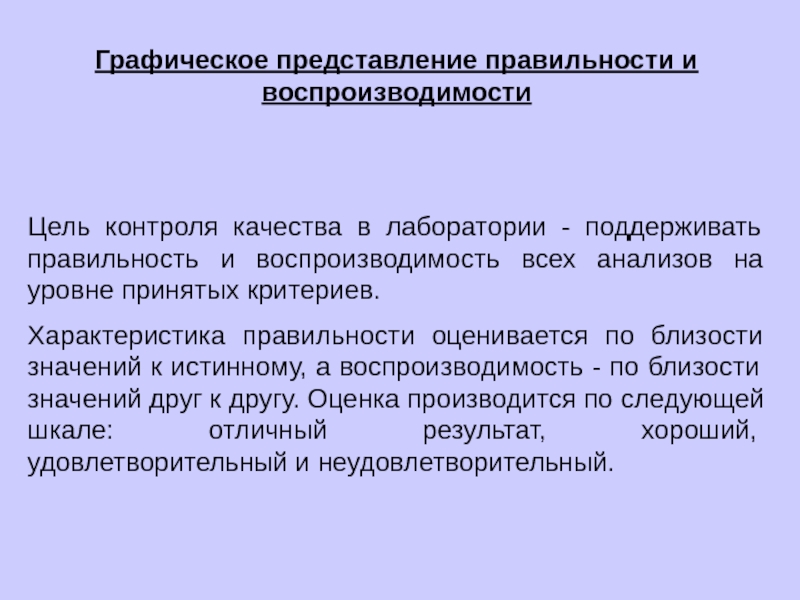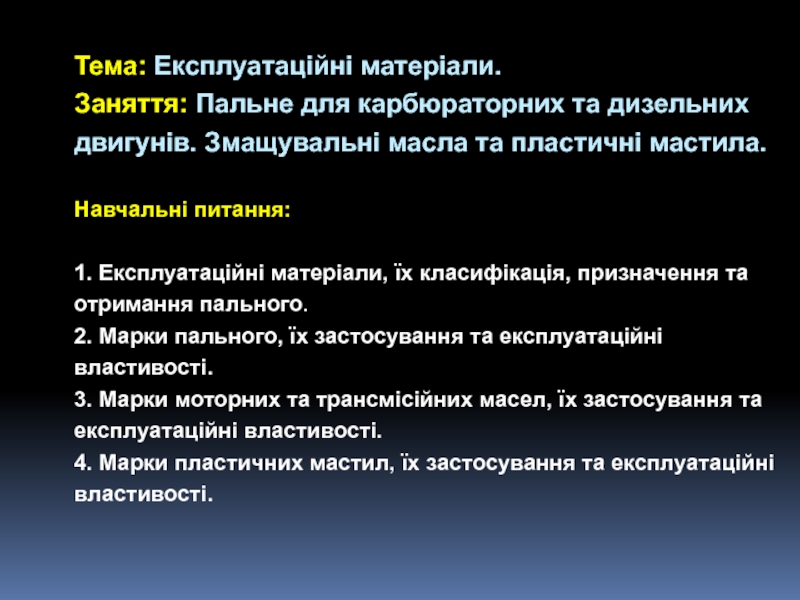Разделы презентаций
- Разное
- Английский язык
- Астрономия
- Алгебра
- Биология
- География
- Геометрия
- Детские презентации
- Информатика
- История
- Литература
- Математика
- Медицина
- Менеджмент
- Музыка
- МХК
- Немецкий язык
- ОБЖ
- Обществознание
- Окружающий мир
- Педагогика
- Русский язык
- Технология
- Физика
- Философия
- Химия
- Шаблоны, картинки для презентаций
- Экология
- Экономика
- Юриспруденция
ENTERIC BACTERIAL PATHOGENS
Содержание
- 1. ENTERIC BACTERIAL PATHOGENS
- 2. Слайд 2
- 3. FAMILY ENTEROBACTERIACEAEare a large heterogeneous group of
- 4. FAMILY ENTEROBACTERIACEAEMost of the members of Enterobacteriaceae
- 5. Слайд 5
- 6. FAMILY ENTEROBACTERIACEAEGram «-» rodsSpores «-»Capsula «+» or
- 7. FAMILY ENTEROBACTERIACEAE
- 8. FAMILY ENTEROBACTERIACEAEThe differential culture media that contain
- 9. Endo Medium
- 10. Kligler Iron Agar
- 11. Kligler Iron AgarKligler iron agar is used
- 12. Kligler Iron Agar
- 13. Kligler Iron AgarThe lactose-positive and glucose-positive bacteria
- 14. FAMILY ENTEROBACTERIACEAEEnterobacteriaceae have a complex antigenic structure.
- 15. FAMILY ENTEROBACTERIACEAEVirulence factors:FimbriaeEnterotoxinsHemolysinsEndotoxins
- 16. FAMILY ENTEROBACTERIACEAEEpidemiology:They are pathogenic for human and
- 17. FAMILY ENTEROBACTERIACEAE Microbiological diagnosis.Specimens : feces, vomit, food,urine, blood. Methods: bacteriological, serological, biological.
- 18. Salmonellae Salmonella Family – EnterobacteriaceaeGenus –
- 19. Salmonella
- 20. Слайд 20
- 21. Слайд 21
- 22. Слайд 22
- 23. Bismuth Sulfite agar
- 24. Salmonella Biochemical activity: Glucose «+», Maltose «+»,
- 25. Salmonella Antigenic structure:O-somatic (serogroups), is destroyed by
- 26. Salmonella. Antigenic structureBased on the presence
- 27. Salmonella. Antigenic structureThe H-antigens are designated
- 28. Salmonella Resistance:Survive in ice for several months.Survive
- 29. Salmonella Virulence Factors
- 30. Salmonella Virulence FactorsThe type III protein secretion
- 31. Salmonella Salmonella are often pathogenic for humans
- 32. PathogenesisThe ingested salmonellae reach the small intestine,
- 33. Pathogenesis of enteric fever1st stage – the
- 34. Laboratory DiagnosisBlood cultures are positive only in
- 35. Salmonella Infections. Treatment .Antimicrobial treatment.Replacement of fluids
- 36. Слайд 36
- 37. SHIGELLA The causative agent of dysentery
- 38. SHIGELLA Shigellosis (or bacillary dysentery) is
- 39. TaxonomyFamily – EnterobacteriaceaeGenus – ShigellaSpecies - S. dysenteriae, S. flexneri, S. boydii, S. sonnei.
- 40. Слайд 40
- 41. SHIGELLAShigella are slender gram-negative rods. Spores
- 42. Ploskirev agar
- 43. Endo agar
- 44. Levine Eosin Methylene Blue agar
- 45. SHIGELLAAll Shigella ferment glucose, form acid.
- 46. SHIGELLAShigella-induced infections are almost always limited
- 47. ShigellosisShigellosis is the infection with fecal-oral route
- 48. Shigellosis. Diagnostic Laboratory TestsSPECIMENS: Fresh stool, mucus
- 49. Shigellosis. Treatment and Immunoprophylaxis AB - Ciprofloxacin,
- 50. Скачать презентанцию
FAMILY ENTEROBACTERIACEAEare a large heterogeneous group of Gram«-» rods whose natural habitat is the intestinal tract of humans and animals.Genera (20) 1. Escherichia2. Salmonellae3. Shigellae4. Klebsiellae5. Yersinia …..
Слайды и текст этой презентации
Слайд 1 ENTERIC BACTERIAL PATHOGENS
Department of Microbiology, Virology & Immunology
Ass. Prof.
E. O. Kravtsova
Слайд 3FAMILY ENTEROBACTERIACEAE
are a large heterogeneous group of
Gram«-» rods whose
natural habitat is the intestinal tract of humans and animals.
Genera
(20) 1. Escherichia
2. Salmonellae
3. Shigellae
4. Klebsiellae
5. Yersinia …..
Слайд 4FAMILY ENTEROBACTERIACEAE
Most of the members of Enterobacteriaceae are facultative anaerobes,
ferment a wide range of carbohydrates, possess a complex antigenic
structure, and produce a variety of toxins and other virulence factors.This family is characterized biochemically by the ability to ferment glucose with the production of acid or acid and gas, and to reduce nitrates to nitrites.
All members of this family are oxidase-negative.
Слайд 6FAMILY ENTEROBACTERIACEAE
Gram «-» rods
Spores «-»
Capsula «+» or «-»
They are motile
(E.coli) or non-motile (Shigellae)
Facultative anaerobes
T= 30-37ºC
pH= 7,2-7,5Endo medium, Ploskirev medium, Levin medium, MacConkey agar.
Oxidase «-», Glucose «+», Lactose «-» ex.E.coli,
Mannitol «+», Indol «-» ex.E.coli, H2S «-» or «+».
Слайд 8FAMILY ENTEROBACTERIACEAE
The differential culture media that contain carbohydrates and special
dyes (indicators) are used to distinguish lactose-fermenting bacteria that form
colored colonies from non-lactose-fermenting microorganisms producing colorless colonies on such differential media.These culture media can allow rapid identification of enteric bacteria.
Слайд 11Kligler Iron Agar
Kligler iron agar is used for the differentiation
of the Enterobacteriaceae members on the basis of their ability
to ferment glucose and lactose and to liberate sulfides.Gas formed by carbohydrates fermenters is detected as bubbles or by splitting or displacement of the agar.
Hydrogen sulfide production is evidenced by a black color either throughout the butt, or in a ring formation near the top of the butt.
Слайд 13Kligler Iron Agar
The lactose-positive and glucose-positive bacteria show both the
slant and the butt yellow in color (E. coli).
The lactose-negative
and glucose-positive bacteria show the yellow butt and the red slant (Salmonella, Shigella).If the bacterium is glucose -negative and lactose-negative, both the butt and the slant remain red.
Hydrogen sulfide production is evidenced by a black color either throughout the butt, or in a ring formation near the top of the butt.
Слайд 14FAMILY ENTEROBACTERIACEAE
Enterobacteriaceae have a complex antigenic structure.
They are classified
by more than 150 different heat-stable somatic O (lipopolysaccharide) antigens,
more than 100 heat-labile K (capsular) antigens, and more than 50 H (flagellar) antigens.In Salmonella Typhi the capsular antigen is called Vi- antigen.
The antigenic classification of Enterobacteriaceae often indicates the presence of each specific antigen.
Слайд 16FAMILY ENTEROBACTERIACEAE
Epidemiology:
They are pathogenic for human and animals.
They are transmitted
by the fecal-oral route.
They may be responsible for hospital infections.
The
main clinical symptoms are diarrhea, vomiting, temperature.Слайд 17FAMILY ENTEROBACTERIACEAE
Microbiological diagnosis.
Specimens : feces, vomit, food,urine, blood.
Methods: bacteriological, serological, biological.
Слайд 18Salmonellae
Salmonella
Family – Enterobacteriaceae
Genus – Salmonellae
Species - S. enterica
Subspecies –
S. typhi, S. paratyphi A, S. paratyphi B,
S. enteritidis, S. typhimuriumThe main taxonomic groups of salmonella are:
Family → Genus → Species → Subspecies → Serovar
S. typhi was discovered in 1880 by K. Eberth and isolated in pure culture in 1884 by G.Gaffky.
Слайд 20
Salmonella
Morphology:
Gram «-» rods
Spores «-» Capsula «-» They are
motile Cultural properties:
Facultative anaerobes Chemoorganotrophs
Topt= 35-37̊º C pH= 6,8-7,2
Endo medium, Ploskirev medium – pale pink colonies. Levin medium – blue colonies
MacConkey agar- colourless colonies
Bismuth-Sulfite agar – black colonies.
In MPB they produce a uniform turbidity.
Слайд 24Salmonella
Biochemical activity:
Glucose «+», Maltose «+», Mannitol «+» (acid)
S.paratyphi
ferments carbohydrates with acid and gas formation.
Lactose «-»
Sucrose «-»Indol «-», H2S «+»
Gelatin – does not liquefy
Oxidase «-»
Слайд 25Salmonella
Antigenic structure:
O-somatic (serogroups), is destroyed by formalin.
H – flagellar (serovars)
, is destroyed by phenol.
Vi – antigen is located on
the surface of the bacterial cell , is destroyed by phenol and temperature.Kauffmann and White classified Salmonellae according their antigenic structure.
Слайд 26Salmonella. Antigenic structure
Based on the presence of O-antigens, the
Salmonella have been assigned to serogroups. The O group is
designated by capital roman letter (A, B, C, D).Each Salmonella serogroup can be identified by the slide agglutination test.
Слайд 27Salmonella. Antigenic structure
The H-antigens are designated by small roman
letters and are kept in brackets (phase 1) and by
arabic numerals for phase 2.The use of specific H- antisera helps to identify the Salmonella serovars.
Слайд 28Salmonella
Resistance:
Survive in ice for several months.
Survive in butter, meat, cheese,
bread for 1-3 months.
Survive in water and soil for several
weeks.Susceptible to heat, t= 60-100º C.
Susceptible to disinfectant solutions of phenol, chloramine.
Слайд 30Salmonella Virulence Factors
The type III protein secretion system (T3SS) encoded
by Salmonella pathogenicity island 1 (SPI-1) delivers effector proteins required for
intestinal invasion and the production of enteritis.SPI-1 encodes transcription factors that regulate the expression of some virulence factors of Salmonella, while other transcription factors encoded outside SPI-1 participate in the expression of SPI-1-encoded genes.
SPI-1 genes are responsible for the invasion of host cells, regulation of the host immune response, the host inflammatory response, apoptosis, and biofilm formation.
Слайд 31Salmonella
Salmonella are often pathogenic for humans or animals when acquired
by the oral tract.
S. typhi, S. paratyphi A, and
S. paratyphi B are the causative agents of enteric fevers. Other species of salmonellae are the bacteria causing salmonellosis, a food-borne infectious disease (enteritis).
The enteric fevers are transmitted by the fecal-oral route.
Слайд 32Pathogenesis
The ingested salmonellae reach the small intestine, from which they
enter the lymphatics (Peyer’s patches) and then the bloodstream. After
an incubation period of 10-14 days, fever, malaise and headache occur due to bacteriemia and toxicity of Salmonella by-products.The skin may become dotted with small hemorrhages called “roseoles”.
Gastrointestinal symptoms appear late in the course of the disease. Blood cultures are positive only in the first week of the disease.
At the beginning of the second week microbes are carried by the blood to many organs, including the liver, kidneys and the intestine. Salmonellae multiply in intestinal lymphoid tissue, kidneys and are excreted in stools and urine.
The stools and urine cultures give positive results on the second and third week.
Слайд 33Pathogenesis of enteric fever
1st stage – the ingestion
2nd stage –
the invasion
3rd stage – bacteremia
4th stage – bacterial dissemination
5th stage
– hyperergia and excretion6th stage – final stage
Immunity acquired is relatively stable but relapses and reinfections sometimes occur.
Слайд 34Laboratory Diagnosis
Blood cultures are positive only in the first week
of the disease.
At the beginning of the second week
microbes are carried by the blood to many organs, including the liver, kidneys and the intestine. Salmonellae multiply in intestinal lymphoid tissue, gallbladder, kidneys and are excreted in stools and urine. The stools and urine cultures yield positive results on the second and third week.
A positive culture of bile establishes the presence of Salmonella genus in the biliary tract of carriers.
Слайд 35Salmonella Infections. Treatment .
Antimicrobial treatment.
Replacement of fluids and electrolytes are
essential.
Susceptibility testing is an important method to choosing a
proper antibiotic, because multiple drug resistance is a big problem in enteric bacteria.Слайд 37 SHIGELLA
The causative agent of dysentery was described in
1888 by A. Chantemesse and in 1891 by A. Grigoryev
and F. Widal.In 1898 this organism was studied in detail by K. Shiga in Japan.
In 1900 S. Flexner in the Philippines isolated dysentery organisms.
Later other bacteria causing dysentery were discovered. According to the current International Nomenclature, all dysentery bacilli are grouped together in one genus known as Shigella.
Слайд 38 SHIGELLA
Shigellosis (or bacillary dysentery) is a clinical condition
characterized by fever, bloody diarrhea, and fecal leukocytosis. Classical bacterial
dysentery is associated with infections caused by any of the four Shigella species:Sh. dysenteriae, Sh. flexneri, Sh. boydii,
Sh. sonnei.
Слайд 39Taxonomy
Family – Enterobacteriaceae
Genus – Shigella
Species - S. dysenteriae, S. flexneri,
S. boydii,
S. sonnei.
Слайд 41 SHIGELLA
Shigella are slender gram-negative rods.
Spores «-»
Mirocapsula «+»
They
are non-motile
They are facultative anaerobes, but grow best aerobically.
Слайд 45 SHIGELLA
All Shigella ferment glucose, form acid.
With the exception
of Shigella sonnei, they do not ferment lactose.
Glucose «+»
Lactose «-» Mannitol «+» (S.dysenteriae «-») H2S «-»
Antigens: O – somatic antigen, K-surface antigen.
Слайд 46 SHIGELLA
Shigella-induced infections are almost always limited to the gastrointestinal
tract; bloodstream invasion is quite rare.
All Shigellae produce endotoxin.
Microabscesses in the wall of the large intestine lead to necrosis of the mucous membrane, superficial ulceration and bleeding.Shigella dysenteriae also produces a heat-labile exotoxin that affects both the gut and the central nervous system.
Слайд 47Shigellosis
Shigellosis is the infection with fecal-oral route of transmission.
After a
short incubation period (1-2 days), there is a sudden onset
of abdominal pain, fever, and watery diarrhea.A day or so later, as the infection involves the ileum and colon, the number of stools increase; they are less liquid but often contain mucus, pus and blood.
In children and the elderly, loss of water and electrolytes may lead to dehydration, acidosis, and even death.
Infection is followed by a type-specific immune response, but reinfection may occur.
Слайд 48Shigellosis. Diagnostic Laboratory Tests
SPECIMENS: Fresh stool, mucus flakes, and rectal
swabs are taken for culture.
BACTERIOLOGICAL EXAMINATION:
The specimen is streaked
on Ploskirev, (MacConkey or Levine EMB agar).Colorless (lactose-negative) colonies are inoculated into the Kligler iron agar.
Organisms that not produce H2S and produce acid but not gas in the butt of the Kligler agar (glucose «+»), and that are nonmotile should be subjected to the slide agglutination test by specific Shigella antisera.
Слайд 49Shigellosis. Treatment and Immunoprophylaxis
AB - Ciprofloxacin, ampicillin, tetracycline, chloraphenicol
The
eubiotics may be effective in limiting multiplication. There are no
vaccines available for immunoprophylaxis of bacterial dysentery.isolation of patients and disinfection of excreta,
detection of subclinical cases,
sanitary control of water, food, and milk.
